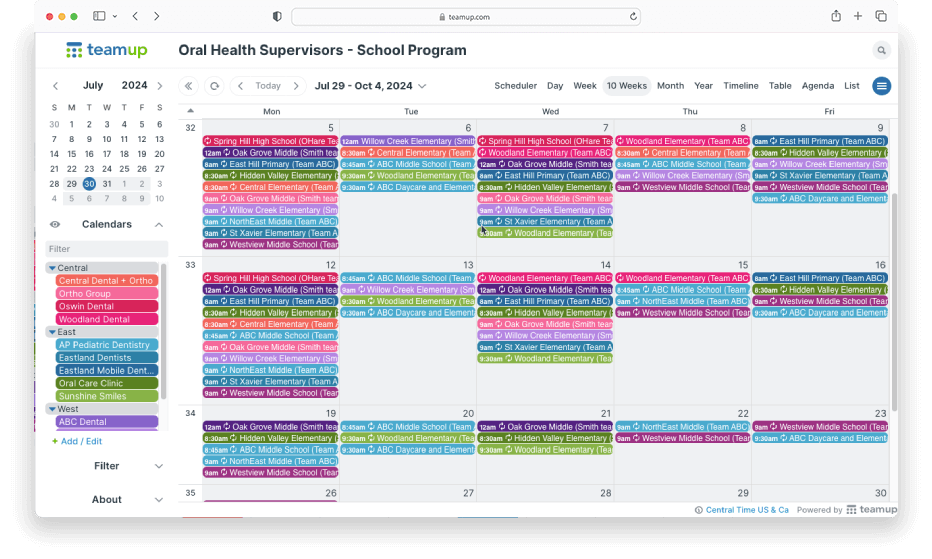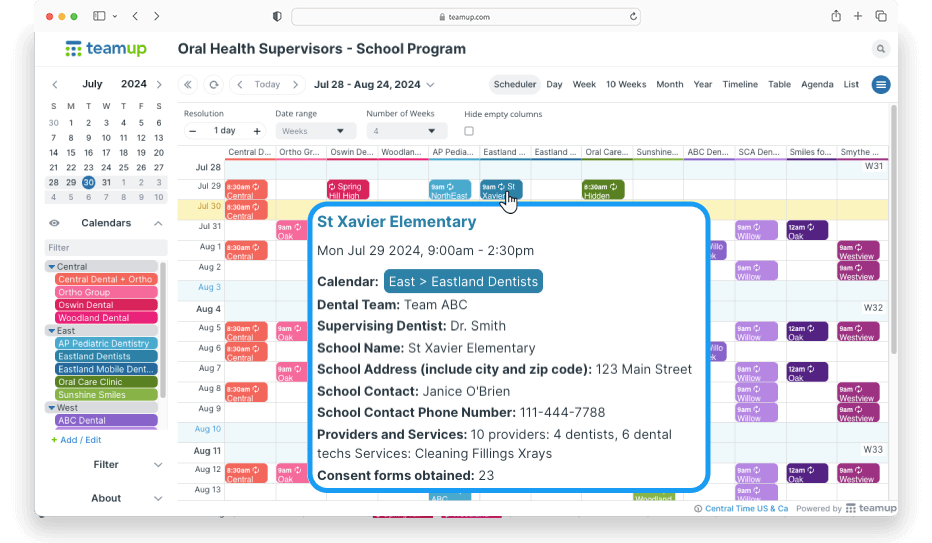This team of oral health consultants in Illinois, U.S. oversees quality assurance for a comprehensive statewide program that brings dental care directly to students in schools. Their work requires coordinating with 50+ independent dental providers who travel across Illinois. It’s a logistical challenge that once meant juggling dozens of separate calendars.
With Teamup, they eliminated the “nightmare” of chasing down provider information, checking different calendars, and juggling multiple logins to schedule on-site audits. The result: A consolidated view of all provider calendars in one place, allowing the team to quickly check schedules and efficiently schedule on-site audits across the state.
—Sherri Foran
SUCCESS SUMMARY
- Unified 50+ provider calendars into one consolidated, filterable view.
- Eliminated multiple logins with secure, centralized access controls.
- Preserved provider autonomy via sub-calendars and granular permissions.
- Improved audit readiness with reliable schedules, change tracking, and notifications.
- Captured consistent data using custom fields; enabled fast filtering, export, and mapping.
- Scaled smoothly as the program grew, adding providers/regions without disruption.
About Illinois DOH – Oral Health Section
- Organization: Illinois Department of Health – Oral Health Section
- Location: Illinois, United States
- Industry: Public Health / Healthcare Administration
- Size: Statewide program overseeing 50+ dental providers
- Summary: The Oral Health Section provides quality assurance and oversight for a school-based oral health program that brings mobile dental equipment and services directly to students across Illinois schools.
- Key Service: Quality assurance audits and oversight of dental providers serving students in school-based settings.
Challenge: A nightmare of schedule silos
To conduct regular audits of each provider, the consulting team must know each provider’s scheduled school visits. But keeping up with 50 separate schedules was a frustrating task.
We had probably close to 50 providers and so we had 50 separate Google calendars, 50 separate usernames, 50 separate passwords that were constantly getting changed. It was a nightmare. Because the providers administrated their own calendars, they could change their login information and then we would have to call or email to get it.
—Sherri Foran, Public Service Administrator
Juggling dozens of calendars and chasing down login details not only took extra time from the OHS team, it also affected their ability to conduct audits without alerting the providers ahead of time.
Administrative burden
Managing 50+ separate calendars with changing login credentials required frequent follow-up calls and emails to maintain access.
Lack of consolidated visibility
The team could not view all provider schedules on one screen. Scheduling required tab switching and left lots of room for error.
Limited audit capabilities
Gaining access to the schedules meant alerting providers in advance.
No accountability
It was impossible to identify who modified schedules, making it difficult to follow up on last-minute changes or missing updates.
Data limitations
There wasn’t a practical way to integrate provider scheduling data with other systems to analyze or generate comprehensive reports.
Buried program scope
Determining scope required manually checking dozens of separate calendars without any way to consolidate or compare across providers.
The team decided to look for a new scheduling platform, and that’s when they found Teamup.
Solution: Unified overview with provider autonomy
The OHS team switched to Teamup almost four years ago and they haven’t looked back. The system is simple, cohesive, and centrally managed.
The setup:
- One sub-calendar for each provider.
- Customized access for each provider to see and update their own calendar only.
Now with our Teamup calendar, it’s beautiful. It’s all right there on one screen and we can filter it by the different teams. We’re able to export the data. The custom fields are super helpful and we regularly use the automatic mapping from the Where field. If we need to add a new provider, we just create a new sub-calendar and give them access.
—Sherri Foran
Teamup gives the consulting team a complete picture of all scheduled visits across all providers on a single screen. Each provider can still set their own schedule, and has their own unique and secure calendar access. And the OHS team is never kept out of the loop, so they can focus on doing their work instead of chasing down information.
An efficient workflow for the DoH team
Consolidated calendar visibility
A sub-calendar structure with folder organization lets the consulting team see the big picture of all scheduled visits for all providers on one screen.
Filters and data export
Filters make it easy to sort data by by those captured details, find events matching multiple criteria, or focus on particular providers by region. Data can be exported easily for use in other tools.
Change tracking
With customized access, the team can see who made calendar changes and review the most recent updates for any provider or region easily.
Scalable architecture
Easy addition of new providers through sub-calendar creation. As the program expands, they can easily build out Teamup to accommodate more providers, schools, and even add entire regions without disruption.
Consistent information capture
Custom event fields provide a structure for getting consistent schedule details, even across multiple providers. Making any field required ensures that the information isn’t overlooked.
Notifications and syncing
Each member of the consulting team can set up their own notifications for relevant updates. And with the Teamup app, they can get key schedule details — like the school address opened in maps for driving directions — anytime, anywhere.
Smooth scheduling for dental providers
Secure, familiar calendar experience
With customized access, each provider gets secure access to their own schedules, only. So their scheduling process doesn’t change much. The experience is very similar to what they’re used to, when they used their own Google calendar. The big difference: Now they don’t have to worry about keeping the DoH team updated when they make schedule adjustments. The unified system eases the workload for providers, too.
Mobile access
Providers can use the Teamup app to view and update their schedules anywhere. Schedules stay synced for everyone, across all devices, automatically.
Results: Efficient, comprehensive oversight
Central control makes scheduling much more efficient for the consulting team. They can view provider schedules side-by-side, see updates and changes, work with data from all providers, and stay informed for efficient quality assurance work. This setup provides the control they need while still letting providers do autonomous scheduling. It’s easier for everyone.
If we had to say one word about how we’re using Teamup and how it’s changed our program, the word would be efficiency. Now we’re better able to locate where teams are and provide the proper quality of safe care assurance. We had to spend so much time chasing down logins and passwords; now we can work more closely with the program. Efficiency is how Teamup has changed our program.
—Sherri Foran
Getting started with a new system always requires some learning, especially when you’re rolling the system out to many independent providers. With some support from Teamup, this dedicated team has an efficient system in place. It’s robust enough to handle the complex coordination of a statewide health program while remaining simple and flexible enough for each independent provider to use effectively.
- Eliminated administrative overhead of managing 50+ separate calendar systems, login credentials, and password changes.
- Achieved complete scheduling visibility with all provider calendars consolidated on one screen.
- Improved audit effectiveness through reliable access to current scheduling information without compromising the element of surprise.
- Enhanced data utilization with all provider scheduling information in one place, consistent information capture, and export capabilities.
- Scaleable system efficiency with a structure that can easily expand to accommodate program growth and new provider additions without disruption.
Thanks to Sherri and team for sharing your story with us.
Make it work for you
This case shows how organizations working with many independent service providers can run things smoothly while still letting each provider make their own decisions. This approach works well for public health programs, quality assurance teams, educational services oversight, and any situation where you need central control but also want local teams to operate on their own.
Key takeaways
- Central visibility doesn’t eliminate autonomy. Providers can handle their own scheduling while managers get the oversight they need.
- Scalable architecture prevents future disruption. Systems that can grow with the program avoid the need for costly migrations or service disruption.
- Custom fields and filtering create operational intelligence. Structured data capture makes scheduling information usable for analysis and strategic planning.
- Secure access controls enable compliance. Granular permissions and individualized access provide accountability and ensure that sensitive scheduling information is handled appropriately.
If your team or organization struggles with fragmented scheduling across multiple providers, contractors, or locations, it’s time to look into Teamup. Benefit from consolidated calendar management, a unified overview, and central control while still allowing service providers to function independently. Check out all the features with a live demo calendar or get started with your own calendar now.





